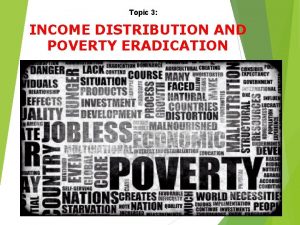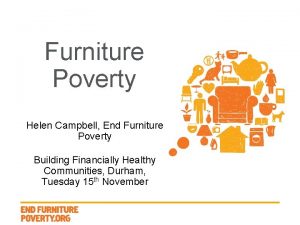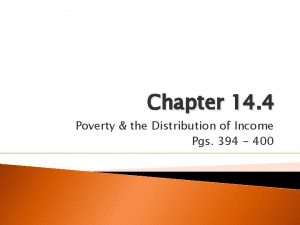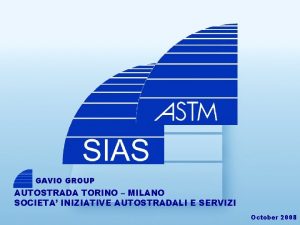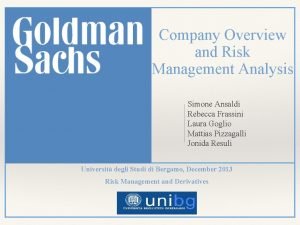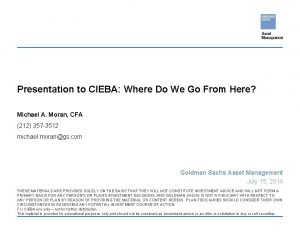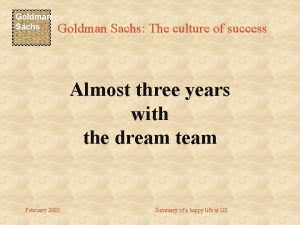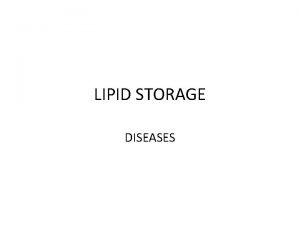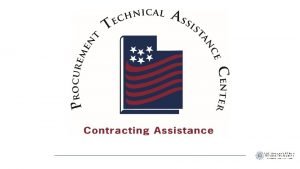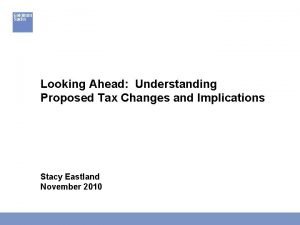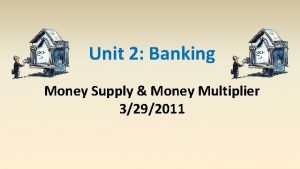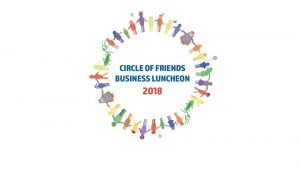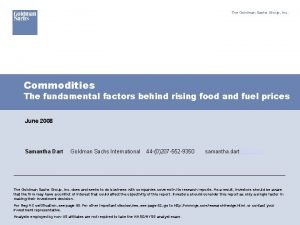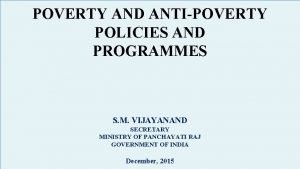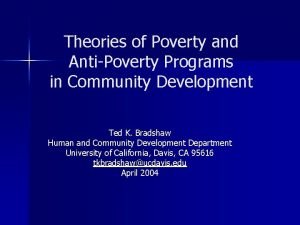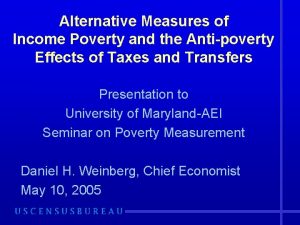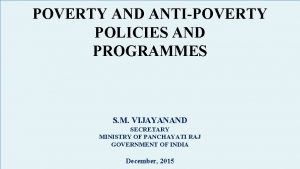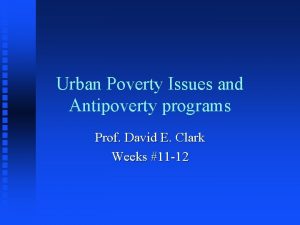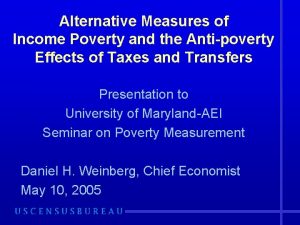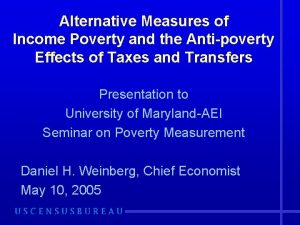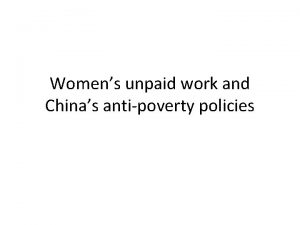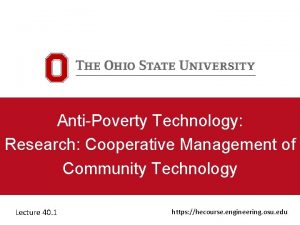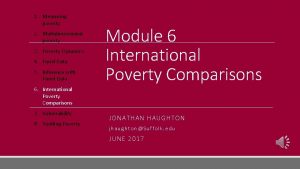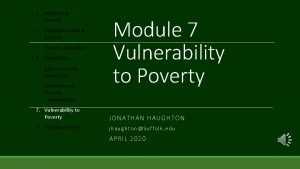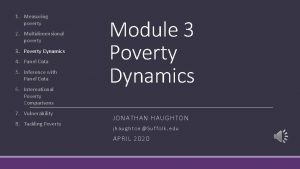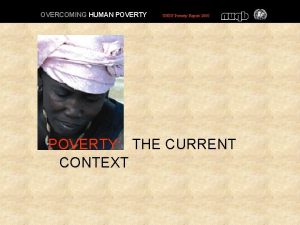AntiPoverty Technology Jeffrey Sachs The End of Poverty








































- Slides: 40

Anti-Poverty Technology: Jeffrey Sachs, The End of Poverty Banerjee/Duflo, Poor Economics Lecture 20. 1 https: //hecourse. engineering. osu. edu

Jeffrey Sachs: • Professor of economics at Columbia University • Director of Columbia’s Earth Institute • Past Director of the U. N. Millennium Project work on the Millennium Development Goals (advisor), Millennium Villages Project (joint EI/UN) • Book: “The Age of Sustainable Development” (Coursera) Here, book: “The End of Poverty” 2

Why are countries poor? Poverty trap: Extreme poverty makes it impossible to get out of poverty (lack of infrastructure, can’t save, lack of human/natural capital, local conditions promote health problems which promote poverty). Need outside help to break the trap! 3

Physical geography: 1. Natural resources (fertile soil, water, ports) 2. Landlocked—high cost transport 3. Tropics promote diseases But, all these issues can be overcome 4

Government fiscal trap: 1. Can’t provide infrastructure, healthcare, education, etc. to get economic growth 2. Cannot raise enough taxes 3. May be “inept, corrupt, or incapacitated” and hence unable to collect taxes 4. Carrying a large debt load that they need to “service” 5

Governance failures: 1. Oriented toward development? 2. Invest in the right projects 3. Set the right environment for private investments, not demand bribes and side payments 4. Maintain peace and safety, and protect private property. 5. Without, “state failure” can occur (e. g. , via wars, revolution, coups, and anarchy) 6

Cultural barriers: 1. Cultural or religious norms may obstruct women (hurt half population). 2. Denying women education: lack of economic productivity for their family, increased family size and child-rearing responsibilities 3. Similar barriers are sometimes set up for religious or ethnic minorities 7

Geopolitics: 1. Trade barriers erected (by rich and powerful countries) that impede a poor country’s development. 2. Economic sanctions are used against poor countries, ones supposedly aimed at an authoritarian leader, but which mainly adversely affect the population. 8

Lack of technological innovation: • Poor country, innovation: How do innovators recover investment in research and development? Sales? • Rich country, innovation: Sales, increases size of market, which encourages more innovation. 98% of patents in rich countries • Opportunities: 1. Diffusion/importation of technology (e. g. , cell phones and computers) but will technologies designed for the ecological conditions in rich countries be reliable in tropical, arid, or mountainous regions where the poor live? 2. Foreign investors bring technology/methods that 9 “spill over”

Demographic trap: • ½ world at “replacement” fertility rate • Country GDP increases ➞ Total fertility rate decreases Poor country fertility rate: ≥ 5 ➞ Population doubles each generation. • Large family size ➞ less invested in each child’s nutrition, health, and education • Impoverished children ➟ impoverished adults, who in turn have many children. • Stresses farm size, natural resources ➞ promote poverty. • Need to have enough boys that will survive to support parents in old age. Countries who broke these traps: Used food productivity 10

Big 5 Development Interventions Agricultural: 1. Fertilizers, fallows, green manures and cover crops, small-scale irrigation, and better seeds ➞ increase yields and end chronic hunger. 2. Storage facilities would help farmers get better market prices. 11

Basic health: 1. A staffed village clinic (e. g. , for every five thousand people) that would also provide bed nets, medicines, HIV/AIDS medicines (e. g. , low-cost Bactrim to treat AIDSinduced infections and antiretroviral therapy for late stage AIDS) 2. Reproductive health services. 12

Education: 1. Meals for children at school, vocational training (e. g. , for farming), computer literacy, infrastructure maintenance (e. g. , electrical wiring, generator use, water harvesting, and borewells), carpentry, etc. 2. Training in hygiene, HIV/AIDS, malaria control, computer and mobile phone use, and others are important. 13

Power, transport, and communications: 1. Electricity via a power line to the grid, or via off-grid methods (diesel generators, bicycles, solar, etc. ), are needed to power lights (to work or study after dark), perhaps a computer for a village school, water pumps, power for milling grain, refrigeration, construction, charging of batteries, etc. 2. A village truck would be useful for delivering goods to the village, taking goods to market, or in case of emergency deliver people to a distant hospital. 3. Having at least one cell phone nearby (if it can get a signal) is useful for emergencies, market information (so they can sell their goods at the best price), and to connect them with the outside world. 14

Water and sanitation: 1. Sufficient supply of clean water affects health and significantly reduces the toil for women and children to find and carry water. 2. Springs, borewells, and rainwater harvesting can all be useful, as could a pipe to a nearby large-scale storage tank. 3. Proper sanitation is important so that at least the immediate environment is not polluted so that health problems arise (of course concerns for the larger surrounding environment are important too). 15

• Sachs’ cost analysis: $70/person is the cost of applying all these strategies. • To break traps, need such sizable investment from rich countries/donors (so do not just keep pouring money into ending suffering) 16

Abhijit Banerjee, Esther Duflo, Professors of economics, MIT 15 years of work with people living on < $0. 99/day PPP Book: Poor Economics 17

• Highlight problems of: Ideology, Ignorance, and Inertia 18

Hunger: • Poor do not spend extra pennies on food • Extra money ➯ proportion on food does not increase • Concentrate resources on high-calorie + micro-nutrient rich food (which they might not understand)? No. • Extra funds ➯ better-tasting + more expensive calories (e. g. , they may buy rice or wheat rather than millet) 19

• Enough food: Only 2% of world say they do not have enough food • Nutrition-based traps only sometimes • Hunger is not a “big part of the story of the persistence of poverty. ” 20

But, are the poor eating well? Wide-spread malnourishment in underdeveloped countries (about one in five children under the age of three has severe malnourishment) ➯ • Stunted growth • Low weight • Deficits in cognitive functioning (e. g. , low IQ), and smarter people earn more money 21

Some evidence: Better nourishment ➯ higher productivity, but. . . • Employer may not pay more (piece-rate) • Self-employed worker earns more Most not held back by food, but problems with malnourishment ➯ need to improve for children and pregnant mothers 22

• Spend significant money on: weddings, dowries, and christenings (likely to save face) & entertainment (boredom problem) • They think carefully about these (often not believing improvements will happen— “learn not to have hope”), but strong basic need for a pleasant life 23

Health-based traps exist Health ➟ work ➟ income ➟ education ➟ baby health • Eliminating malaria – a good investment • Also, clean water, sanitation • But, demand for bed nets (even subsidized) not large • Do poor care about health? Yes. . . 24

¼ poor report “worried, tense, or anxious” in last month, most often due to their health or that of relative Spend a lot on healthcare, but expensive cures rather than inexpensive prevention (familiar? Often poorly administered) Poorly trained health-providers: “underdiagnose and overmedicate”, high absenteeism Do little things, can’t afford big ones 25

Need education about value of prevention (e. g. immunization), fight against superstitions Should immunizations be forced by law? Contrast this with lives of rich in the developed world. . . 26

1. Live in a house with piped-in clean water (no need to remember to purify water every day), and sewage that goes away without a thought and does not pollute the immediate environment, including the water supply. 2. Do not worry about where their next meal is coming from. 3. Have access to well-trained doctors, other healthcare providers, and a public health system all of which can most often be trusted. 4. Have required immunization (e. g. , by public schools) and if you fail to get it you are likely going to be alright since most other people have gotten it. 5. Have health insurers that reward us for joining the gym or for eating nutritious food. 27

Family Issues • Country’s higher fertility rates ➟ poorer; but poorer due to high fertility? • Family size create poverty for a family (invest less in nutrition, education, and healthcare for each child)? Not clear 28

• Pregnancy (health problems), marriage, lead women to get less education • Contraception: Supply vs demand argument • Women pay most of cost of having babies • Men want more kids than women • Mother-in-law + community drive family size 29

Children a good economic investment? 1. Insurance policy (to take care of parents in their old age) 2. Savings product (to later garner their income) 3. Lottery tickets (not being sure who will succeed well enough to help); big family ➯ one will pay off (risk problems with one) 4. Sons pay off, daughters cost (dowry&leave) 30

• Children are ways to save ➯ when fertility drops, savings go up ➯ do not see for smaller families increases in investment in children (health/education) • Higher value on boys ➯ sex-selective issues & how girls are treated • Have kids till get boy ➯ girls in larger families (where boy was desired) • Sometimes, girls not breast-fed as long to avoid contraceptive effect (try for boy) 31

Risks and Poverty • Risk a key part of lives of poor. • Bad luck hurts the poor more • Risk causes worry, stress, and depression ➯ harder to focus, impair cognition, impair decision-making ability, less productive. • Create employment via farms (weather dependence), small businesses, day-jobs/ indeterminate length 32

• Bad luck ➯ work more? But, if problem wide-spread wages go down • “Diversified portfolio” approach: • Many occupations • More children • Conservative in operations (not invest in a new seed or fertilizer). • Become someone’s share-tenant 33

Rely on social connections to elicit cooperation of other poor people in their community (i. e. , everybody helps everybody else out). 34

Loans to the Poor • High interest (money-lenders) ➟ opportunities for microfinance companies • Micro-loans can help lift someone out of poverty. • Poor generally pay higher interest than the rich for loans (20 -40% per year) • Some companies have charged high rates • Not strong evidence of sucess 35

How The Poor Save • Slowly build a house. • Without credit and insurance, shouldn’t the poor save as much as they can to avoid risk (e. g. , a bad farming year or health problems)? Can’t save what don’t have! • Even saving a little still makes sense. 36

Ingenuity in managing their finances: • “Savings clubs” • Deposit money with moneylenders • Hide money for emergencies. • Cell phones facilitate deposits • Savings behavior ➟ try to protect assets from themselves. Use loans to save? Desperation ➟ immediate spending Hope, optimism, long-term goals ➟ improve 37 saving and has many positive effects

Poor Entrepreneurs • Poor natural-born entrepreneurs? No. • Poor have fresh ideas, initiatives, resilience, but. . . • Their businesses are tiny ➟ loans may not lead to a significant impact on their welfare. But, high “marginal return” • Highly competitive, no profits for investment • A way to “buy a job” (economy fails them) 38

Jobs for the Poor • Want a government job • Employment in a “sweatshop” can provide stable employment • Evidence of the positive influence of employment in sweatshops on women workers in that their children are less stunted in growth. 39

Five Lessons for Helping the Poor 1. The poor need better information 2. The poor are burdened with responsibility for too many aspects of their lives 3. Markets are missing or unfavorable to the poor 4. Poverty and history do not doom a poor country to stay poor: many problems there are due to “the three I’s, ideology, ignorance, and inertia. ” 5. Expectations about what the poor are able or unable to do end up being “self-fulfilling prophecies”. 40
 Principais causas de morte
Principais causas de morte What is absolute poverty
What is absolute poverty End furniture poverty
End furniture poverty End furniture poverty
End furniture poverty End to end delay
End to end delay End-diastolic volume vs end-systolic volume
End-diastolic volume vs end-systolic volume End-to-end wireframe parsing
End-to-end wireframe parsing End to end delay
End to end delay Compiler front end and back end
Compiler front end and back end End to end argument in system design
End to end argument in system design Automatic knowledge graph construction
Automatic knowledge graph construction End to end
End to end Front end back end compiler
Front end back end compiler End to end accounting life cycle tasks
End to end accounting life cycle tasks End-diastolic volume vs end-systolic volume
End-diastolic volume vs end-systolic volume Multiple procurement cycles
Multiple procurement cycles Kolondivertikulose
Kolondivertikulose Goldman sachs case competition
Goldman sachs case competition Gavio group
Gavio group Goldman sachs organizational structure
Goldman sachs organizational structure Goldman sachs partner salary
Goldman sachs partner salary Sean brennan goldman sachs
Sean brennan goldman sachs Credit risk management and advisory goldman sachs
Credit risk management and advisory goldman sachs Goldman sachs the culture of success
Goldman sachs the culture of success Goldman sachs darkpool
Goldman sachs darkpool Goldman sachs mask
Goldman sachs mask Chromosome 15 tay sachs
Chromosome 15 tay sachs Tay sachs disease
Tay sachs disease Goldman sachs 10 000 small businesses requirements
Goldman sachs 10 000 small businesses requirements Stacy eastland goldman sachs
Stacy eastland goldman sachs Gunter sachs jeune
Gunter sachs jeune Tay sachs recessive
Tay sachs recessive Deposit creation
Deposit creation Bdl pharma
Bdl pharma Hornbostel sachs classification of trumpet
Hornbostel sachs classification of trumpet Alanna sachs
Alanna sachs Codominance definition
Codominance definition Goldman sachs risk management framework
Goldman sachs risk management framework Goldman sachs puzzles
Goldman sachs puzzles Goldman sachs icon
Goldman sachs icon Goldman sachs commodities research
Goldman sachs commodities research

